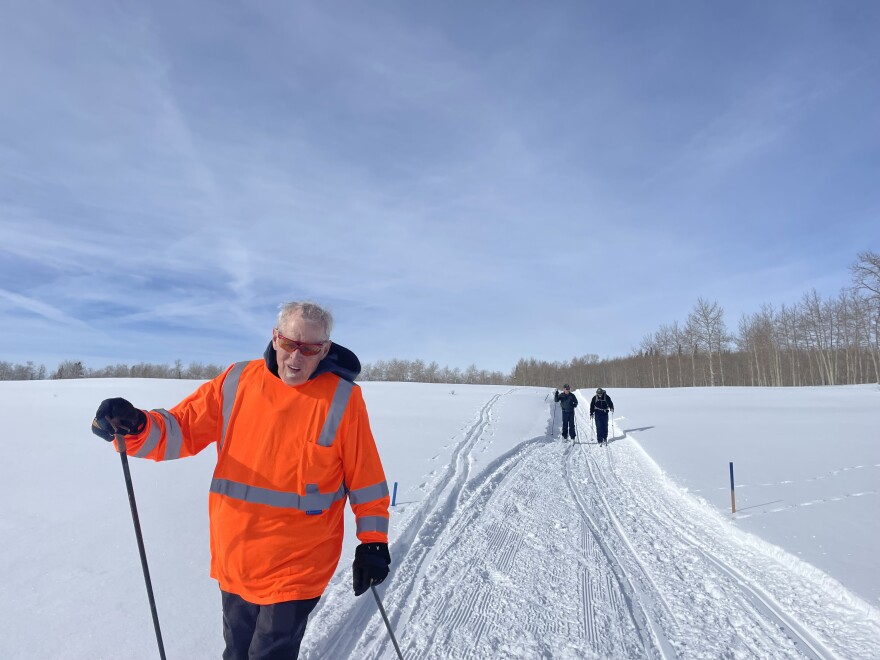On a sunny Friday morning at the West Elk Trails system, located 40 minutes from New Castle up a steep, narrow, winding road lined with snowbanks, a few snowshoers paused near a grove of aspens to savor a snack with a view of Mt. Sopris.
Ines Baquero from New Castle comes out here as often as she can. She’s lived in Colorado for 15 years, and this place, by far, is her favorite.
“In fact, I took my dog’s ashes and put them up here,” Baquero said. “There's a lot of ashes up here I think, dogs and people and it's — just look at this.”
The peace and tranquility of these trails is the main draw for visitors like Baquero and her current pup Lucy, and for her friends Dee Moore from Glenwood Springs and Jackie Nielson from New Castle.
“It’s just gorgeous. Very quiet,” Nielson said. “Most of the time we come up here, we’re the only ones.”
That makes today relatively busy, since this reporter is out on the trails too, along with Tod Tibbetts, who manages the trail system, and Todd Parker and David Boyd from the U.S. Forest Service. Tibbetts’ dog Odin is joining too, as the official mascot and greeter of the West Elk Trails network.
Tibbetts uses a trail camera to keep tabs on human and animal visitors. He said the system currently gets about 1,600 human visits in a season that runs from December to March, and that user numbers are growing by 15 to 20% a year.
Kay Robinson spearheaded the trail project in the early 2000s, when the organization was still known as the West Elk Multi-Use Club, and Tibbetts started managing the trails around 2009.
“Considering when we started out and we had about 300 user visits, 1,600 is a good number,” he said in an interview at the trailhead. “The nice thing about the trail system is you can still go out and ski or snowshoe and be all by yourself. It's seven miles of trails, so there's plenty of room for everybody.”
Tibbetts said the increased visitation helps support snowmobile grooming operations, since more users can turn into more funding. Access to the trails is free, so money for the 501(c)3 nonprofit comes from voluntary user donations and corporate contributions as well as local governments that Tibbetts said look at user participation.
He said visitor contributions come from Glenwood Springs, Carbondale, nearby towns like New Castle, Silt, Rifle, and Parachute, and even some from the Front Range.

But growth doesn’t mean the trails are bustling by any means.
“If I see four people, that's typical, so I think we’ve got room for more up here,” Todd Parker said at the trailhead. He’s the recreation manager for the Forest Service’s Rifle Ranger District, which gives West Elk Trails a special use permit for their grooming operations.
“Upvalley, you know, places see a lot more visitors and some folks like to try out different areas and experience a little bit of solitude,” Parker said. “So I think they're pleasantly surprised when they find this trail.”
David Boyd, a public affairs officer with White River National Forest, sees the significance in a bigger context. He works for the most-visited national forest in the country, where visitation includes users of 11 ski areas and eight wilderness areas; it’s home to iconic and popular destinations like Maroon Lake and Hanging Lake where officials are working to mitigate crowds.
“Every year we're getting busier and busier, it seems,” Boyd said. "And so it's nice to have some of these places that, for whatever reason, [are] a little harder to get to, or a little further away from some of the other popular spots, where you can go and still really experience the forest.”
On the drive back down that winding road after our visit to the West Elk Trails, I asked Boyd whether places like this could be a remedy to hotspots like the Maroon Bells in the summer, or the ski hills in the winter.
“Is it compensatory? Or is it additive? Right?” Boyd said. “It's hard to say. … We’ll continue to see more use in some of these less-known western parts of the forest as more people are moving out here, but yeah, I think so — I think you might see it spread out a little bit.”
The West Elk Trails system grooms on Mondays and Fridays throughout the season, and the last day of grooming this year is March 31. Grooming reports are posted on the West Elk Trails website.





